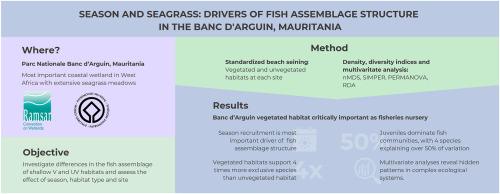季节和海草:毛里塔尼亚阿古因湾鱼类群落结构的驱动因素
IF 2.6
3区 地球科学
Q1 MARINE & FRESHWATER BIOLOGY
引用次数: 0
摘要
阿古因海岸是西非最具生态意义的沿海湿地,是联合国教科文组织海洋世界遗产区,拥有地球上最广阔的海草区之一,许多海洋物种将其用作繁殖和/或觅食栖息地。然而,人们对这些广阔的海草草甸所支持的潮下生物多样性知之甚少。本研究旨在评估潮下海草植被对鱼类组合的影响,利用海滩围网比较有植被和无植被的栖息地。对季节和地点的影响也进行了评估。我们取样的鱼类群落主要由幼鱼组成(98.7%)。具体来说,我们分析了这些因素在丰度、物种丰富度、多样性、均匀性和组合结构方面的差异。正如预期的那样,在鱼类季节性繁殖的苗圃区,季节是鱼类组合结构最具影响力的驱动因素,甚至超过了栖息地。值得注意的是,在不同生境和季节的组合变异中,有4种(Atherina boyeri、Eucinostomus melanopterus、Mugil capurrii和Chelon dumerili)分别占53.7%和49.2%。此外,仅在海草栖息地发现的物种数量是在无植被地区发现的物种数量的四倍,这突显了阿古因湾海草草甸在支持依赖这种浅层庇护栖息地的物种、增强区域生物多样性和促进渔业可持续性方面的关键作用。本文章由计算机程序翻译,如有差异,请以英文原文为准。

Season and seagrass: drivers of fish assemblage structure in the Banc d'Arguin, Mauritania
The Banc d’Arguin is the most ecologically significant coastal wetland of West Africa, a UNESCO Marine World Heritage area with one of the most extensive seagrass areas on Earth, used by many marine species as breeding and/or feeding habitat. However, little is known about the subtidal biodiversity supported by these extensive seagrass meadows. This study aimed to assess the influence of subtidal seagrass vegetation on fish assemblages, using beach seines to compare vegetated and unvegetated habitat. Effects of season and site were also assessed. We sampled fish communities predominantly composed of juveniles (98.7 %). Specifically, we analyzed differences in abundance, species richness, diversity, evenness, and assemblage structure across these factors. Season was the most influential driver of fish assemblage structure, even more than habitat, as expected in a nursery area where fish reproduce seasonally. Notably, four species - Atherina boyeri, Eucinostomus melanopterus, Mugil capurrii, and Chelon dumerili - accounted for 53.7 % and 49.2 % of the variation in assemblages across habitat and season, respectively. Moreover, four times as many species were found exclusively in seagrass habitats compared to unvegetated areas, underscoring the critical role of seagrass meadows in the Banc d'Arguin in supporting species that depend on such shallow sheltered habitats, enhancing regional biodiversity, and contributing to the sustainability of fisheries.
求助全文
通过发布文献求助,成功后即可免费获取论文全文。
去求助
来源期刊
CiteScore
5.60
自引率
7.10%
发文量
374
审稿时长
9 months
期刊介绍:
Estuarine, Coastal and Shelf Science is an international multidisciplinary journal devoted to the analysis of saline water phenomena ranging from the outer edge of the continental shelf to the upper limits of the tidal zone. The journal provides a unique forum, unifying the multidisciplinary approaches to the study of the oceanography of estuaries, coastal zones, and continental shelf seas. It features original research papers, review papers and short communications treating such disciplines as zoology, botany, geology, sedimentology, physical oceanography.

 求助内容:
求助内容: 应助结果提醒方式:
应助结果提醒方式:


